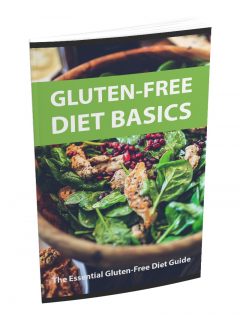 License Type: Master Resell Rights
License Type: Master Resell Rights  File Type: ZIP
File Type: ZIP
 SKU: 61979
SKU: 61979  Shipping: Online Download
Shipping: Online Download
Sample Content Preview
Introduction
The fact that you have decided to read this book is evidence that the Gluten Free movement is steadily increasing in popularity. People all over the world have decided that avoiding Gluten was not just another diet option but it was absolutely crucial for the sake of their health. This is not just another fad that will lose momentum before you get time to even research it and it is certainly not another crazy crash diet. This change has been regarded as one of the most practical ways for a lot of people to shed pounds, take charge of their health and start feeling like themselves again. But make no mistake, this diet is not for everyone.
Sticking to a Gluten Free diet will lead you down a path that may be viewed as wrought with adversity. The problem lies is the fact that Gluten is everywhere! Trying to eliminate an ingredient that is included in such a wide array of foods is bound to cause some challenges. The first challenge will be finding the willpower to stop eating quite a bit of the food you have grown to love. This is much easier said than done when the ‘healthier’ substitute is not as tasty. The next challenge will be learning how to get sufficient amounts of the nutrients you need to stay healthy without compromising your decision to avoid Gluten. And if that wasn’t
enough, most of the foods labeled “Gluten Free” may be more expensive than their counterparts.
Whatever you decide, always remember that your body is your home. If you do not take the time to take care of it, where will you live? Taking the time to eat right, get sufficient rest and exercise will always be in your best interest. Performing efficiently and at the highest level of your proficiency will only be possible if you take care of yourself. This might require a little bit more time and a tad bit more effort, but it will certainly be worth it. Unfortunately, there is no ‘one size fits all’ when it comes to our health and well-being. You have to put in the work yourself and evaluate your own unique needs. You will never, ever be able to pour from an empty cup. So trust me, take some time to find out what your body needs and you will not regret it.
By now, you should be wondering if all the fuss is really worth it. And once again, I encourage you to think carefully about whether this diet is really right for you. This diet may not be quite what you need. If it is, however, the benefits will far outweigh any challenges you face as a result of this decision. I hate to sound dramatic, but cutting Gluten from your diet may even save your life. In order for you to be sure this diet is right for you, please continue to read on and learn more about Gluten and why avoiding it is such a big deal. This may very well end up being one of the best decisions you have ever made.
Chapter 1 – What is Gluten?
Put simply, Gluten is one of the proteins found in cereal grains such as wheat, rye and barley. Gluten is produced by a combination of two different Proteins. These Proteins are Gliadin and Glutenin. The plant relies on its supply of Gluten because it serves as food for the plant during development. When these grains are ground into flour, the Gluten is responsible for the elasticity of dough mixtures. It is this elasticity that gives our food a certain “chewiness.” Individuals who suffer from Gluten intolerance are often encouraged to avoid oats as well. This is because oats can easily be contaminated by foods that contain Gluten since it is often processed in factories that produce food using wheat and other foods that contain Gluten. Some examples of gluten-free grains are millet, sorghum, brown rice, buckwheat, wild rice, quinoa and corn.
Wheat is often used to make the following foods:
- Bread
- Pasta
- BakeD goods
- Sauces
- Cakes
- Soups
- Salad dressings
- Battered meat, poultry and fish
Rye is used to make foods such as:
- Pumpernickel bread
- Cereals
- Beer
Barley is often used to make:
- Beer
- Food coloring
- Yeast
- Malt milk
- Malt vinegar
- Soups
Many of the foods we eat may also contain some amount of Gluten as a result of being contaminated during the manufacturing process. These foods include:
- Dried fruit
- Candy
- Flavored coffee
- Caramel color
- Food starch
- French fries
- Processed cheese and meats
- Vegetable and meat stock
- Bouillon cubes
- Dietary Supplements such as multivitamins
- Ice cream
This list is not exhaustive. Time will not permit me to list all the foods that contain or do not contain Gluten and even if I had the time, you would find it quite boring. The only efficient way to determine if your food contains Gluten is to read the label carefully. This will require a lot of your time in order for you to be accurate. This exhaustive process may not be right for everyone. The next chapter will help you to determine whether we are making too much adieu about nothing.
Chapter 2 – Why the Big Deal?
A recent survey highlighted that about a third of all Americans are actively trying to eliminate Gluten from their diet. This is an awful lot of people when we think about the fact that there are over 325,000,000 people in the US. But why are they making such a fuss? Let us take some time to examine a few of the reasons so many people have decided to live Gluten Free.
1. Celiac Disease
Studies have indicated that the number of individuals who currently suffer from Celiac Disease is on the rise. Although no official numbers have been published, it is estimated that well over 1% of the world’s population suffer from this disease. Celiac Disease is especially common among the elderly. Even worse is the fact that many cases of individuals who suffer from this disease have gone undiagnosed. In fact, about 80% of the people who suffer from Celiac Disease are not even aware that they have it.
But what exactly is Celiac Disease you may ask? As highlighted in the previous chapter, Gluten is composed of two main proteins, Gliadin and Glutenin. Individuals with Celiac Disease react
negatively to the Gliadin component. Celiac is classified as an autoimmune disease. That is because the immune system of these individuals will confuse Gluten with something dangerous like some sort of Bacteria. As a result, their bodies try to defend themselves against the Gluten and end up attacking itself in the process. This attack can result in the degeneration of the intestinal wall and can be life threatening if not treated.
Other symptoms of Celiac Disease include:
- Nutritional deficiencies
- Anaemia
- Chronic fatigue
- Vomiting
- Abdominal bloating
- Abdominal pain
- Diarrhea
- Digestive issues
- Decreased appetite
- Itchy skin rashes
- Irritability
- Depression
- Osteoporosis
- Damaged tooth enamel
- Joint pain
- Acid reflux
2. Gluten Sensitivity
Others, who do not suffer from Celiac Disease, have chosen to avoid Gluten or cut it out of their diet altogether because they suffer from Gluten Sensitivity. These individuals may have even gotten a negative result when they did a blood test for Celiac but simply do not feel well when they consume foods that contain Gluten. They may even suffer from symptoms that are quite similar to those of someone with Celiac Disease. Suffering from Gluten Sensitivity means that the individual reacts negatively to Gluten even though their immune system is not attacking their bodies, as is the case with Celiac Disease. The symptoms of Gluten Sensitivity are usually not related to the gastrointestinal tract or cause any damage to the intestines at all. On the contrary, these individuals are more likely to experience fatigue, joint pain, abdominal pain or even ‘brain fog.’ Thankfully, Gluten sensitivity is not life threatening.
- License: Master Resell Rights
- Category:Ebooks
- Tags:2018 Ebooks Master Resale Rights








